What is bursitis of the heel?
- The retrocalcaneal bursa sits between the Achilles tendon and the heel bone, reducing friction between them during repeated movement.
- The subcutaneous calcaneal bursa is located between the Achilles tendon and the skin, once again reducing friction.
If either of these bursae are placed under increased stress due to a sudden change in activity levels, starting a new sport, wearing shoes that do not fit correctly, or due to a direct impact (a shopping trolley hitting the back of your heel) then they can become irritated and inflamed. Heel bursitis can also be caused by systemic inflammatory conditions such as rheumatoid arthritis. When a bursa becomes irritated it can cause considerable pain, this is called a bursitis.
What are the symptoms of heel bursitis?
The symptoms of heel bursitis are:
- Pain felt directly over the back of the calcaneus.
- Redness or swelling over the back of the calcaneus.
- Pain with walking and exercising.
- Pain with resting your weight directly through the heel such as when driving.
- Pain with wearing shoes (especially if they are tight or too small).
- Pain with stretching your calf.
What other conditions can present like a heel bursitis?
Heel bursitis vs insertional Achilles tendinopathy
The Achilles insertion and the heel bursae are very closely related. The Achilles tendon attaches onto the back of the heel bone. The subcutaneous calcaneal bursa lies superficial to the Achilles insertion, just below the skin, and the retrocalcaneal bursa sits between the Achilles tendon and the heel bone. Both a bursitis and an insertional Achilles tendinopathy can occur for the same reason (for example, quickly increasing your activity levels or changing sport). In fact, it is very common for an insertional Achilles tendinopathy and a bursitis to occur simultaneously. This is especially true if you have an inflammatory condition such as rheumatoid arthritis. A bursitis might additionally present with swelling at the heel and pain during the night, this is in contrast to an insertional Achilles tendinopathy which typically doesn’t swell or cause night pain.
Both heel bursitis and an insertional Achilles tendinopathy can occur at any age and is not gender dependant. Both conditions are common in the sporting population as well as sedentary individuals who take up a new exercise regime or sport.
Diagnosing between a bursitis and an insertional Achilles tendinopathy is clinically very difficult. To ensure a correct diagnosis an ultrasound scan is required to assess the quality of the Achilles tendon and the condition of the bursae.
Retrocalcaneal and pre-Achilles bursitis.
What is bursitis?
A bursa is a potential space located between two anatomical structures, such as bone and tendon. Bursa act like a small cushion designed to reduce compression and help provide friction-free motion between adjacent structures.
The heel has two bursae (see images below); one located superficial to the Achilles, known as the subcutaneous bursa and one located deep to the bursa, the retro-calcaneal bursa. The subcutaneous bursa is located between the skin and the Achilles tendon. The retro-calcaneal bursa is located between the Achilles tendon and the calcaneum (heel bone).

Either bursa can become inflamed due to excessive friction and compression. This is known as a bursitis and is often due to overuse or unaccustomed activity. For example, while training for a marathon, increasing your walking distance too quickly or wearing new shoes. The bursa is a very pain-sensitive structure, and when it becomes inflamed can be very debilitating.
Heel bone shape
The shape of your calcaneal (heel) bone can make some people prone to a bursitis. More specifically, if you have been diagnosed with a bony spur or a Haglund’s deformity. A bony spur is when you have an extra piece of bone arising from the heel bone. A Haglund’s deformity is a bony prominence on the heel bone, in front of the Achilles tendon. Both can cause compression and friction on the bursa. Heel bursitis is one of the most common reasons insertional Achilles tendon problems do not improve, especially if your pain is explicitly located on the back of the heel bone.
Why do people get heel bursitis?
Retrocalcaneal bursitis is caused by an increase in mechanical stress on the bursa (Buda et al, 2013).
This can be caused by a variety of reasons:
- If you start a new form of exercise, e.g. you start running
- If you increase your training too quickly
- If you wear a new pair of shoes for the first time
- Wearing shoes that are too small for you. This can cause excessive pressure between the heel and the back of the shoe
- Someone kicking you in the back of the heel or a shopping trolley running into you
How is bursitis diagnosed?
Bursitis of the heel, both retro-calcaneal (deep) and the subcutaneous (superficial), are diagnosed by an ultrasound scan of the heel combined with a clinical assessment. A diagnostic ultrasound scan visualises the bursa and the surrounding structures such as the Achilles tendon, Kager’s fat pad, and the heel bone. Diagnostic ultrasound shows these structures in more detail than an MRI scan.
At Complete Injections, we carry out a diagnostic ultrasound (at no extra cost) before considering an injection for heel pain. If the scan reveals a bursitis, this is a potential target for an injection. A diagnostic ultrasound scan will also reveal if you have a bony spur or a Haglund’s deformity, which can make you prone to a bursitis.

Retro-calcaneal bursitis (*) on diagnostic ultrasound
Is a steroid injection effective for bursitis?
Bursitis is inflammation of the bursa, e.g. a retro-calcaneal or subcutaneous bursitis. A steroid injection, also known as corticosteroid, is a potent anti-inflammatory and is very effective at reducing the pain and swelling associated with a bursitis. This provides a pain-free window to progress your rehabilitation and return to sport/activity.
Bursitis often occur alongside Achilles tendon issues and should always be considered if Achilles problems are not improving.
The injection is just one component of an effective treatment plan for bursitis. Here are some top tips that can also help to reduce your pain and get you back to full function, before or after the injection:
- Wear trainers that have stability control and a heel raise. Flat shoes such as Converse Allstars or ballet pumps will often aggravate your symptoms.
- Avoid wearing slip-on leather shoes or any shoes that are too tight around the heel that may rub on the back of the heel
- See a physiotherapist to commence a strengthening programme for your ankle and foot. This is likely to involve a calf strengthening programme.
- Ice the area twice a day for 15 mins each time. Wrap the ice in a tea towel to ensure you do not burn your skin. Ice burns can be very painful and can permanently scar the skin (just like burns from heat).
What injection is effective for bursitis?
A vast majority of the injections we carry out for a bursitis around the heel will use steroid. We have extensive experience of using steroid for bursitis in a variety of patients, from elite runners to sedentary individuals. If you have a painful, swollen and inflamed bursa, confirmed on ultrasound, then a steroid injection is an effective treatment modality.
Bursitis can be a stubborn condition that does not always respond to conservative treatment and physiotherapy. A steroid injection can provide the breakthrough you require to push on with your rehabilitation. The steroid is combined with a local anaesthetic to ensure the procedure is relatively pain-free. All injections at Complete are carried out using ultrasound guidance to ensure the needle is placed in the correct place to get maximal pain relief.
On occasion, we do use hyaluronic acid or sclerosant injections for bursitis, but steroid is the most common injection we perform. If you would like to discuss these options, please do not hesitate to contact us.
How many injections do you need?
A patient will rarely need more than one injection for either retro-calcaneal or subcutaneous bursitis. One injection normally provides the pain relief required. The number of steroid injections must be limited around tendons, particularly the Achilles tendon.
At Complete Injections, all injections are carried out judiciously and as part of an overall treatment regime.
Our clinicians at Complete Injections are highly skilled in the use of diagnostic ultrasound and carry out ultrasound-guided injections. For more information, please contact us on 020 7482 3875 or email injections@complete-physio.co.uk.


